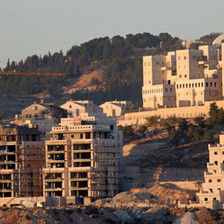The Electronic Intifada 4 March 2008

Mourners stand beside the body of Salsabeel Abu Jalhoumm, a 21-month-old girl who was killed early on Sunday when an Israeli air strike hit near her home in the northern Gaza Strip, 2 March 2008. (Wissam Nassar/MaanImages)
In several articles published by The Electronic Intifada, I claimed that Israel is pursuing a genocidal policy against the Palestinians in the Gaza Strip, while continuing the ethnic cleansing of the West Bank. I asserted that the genocidal policies are a result of a lack of strategy. The argument was that since the Israeli political and military elites do not know how to deal with the Gaza Strip, they opted for a knee-jerk reaction in the form of massive killing of citizens whenever the Palestinians in the Strip dared to protest by force their strangulation and imprisonment. The end result so far is the escalation of the indiscriminate killing of Palestinians — more than one hundred in the first days of March 2008, unfortunately validating the adjective “genocidal” I and others attached to these policies. But it was not yet a strategy.
However, in recent weeks a clearer Israeli strategy towards the Gaza Strip’s future has emerged and it is part of the overall new thinking about the fate of the occupied territories in general. It is in essence, a refinement of the unilateralism adopted by Israel ever since the collapse of the Camp David “peace talks” in the summer of 2000. Former Israeli Prime Minister Ariel Sharon, his party Kadima, and his successor Prime Minister Ehud Olmert, delineated very clearly what unilateralism entailed: Israel would annex about 50 percent of the West Bank, not as a homogeneous chunk of it, but as the total space of the settlement blocs, the apartheid roads, the military bases and the “national park reserves” (which are no-go areas for Palestinians). This was more or less implemented in the last eight years. These purely Jewish entities cut the West Bank into 11 small cantons and sub-cantons. They are all separated from each other by this complex colonial Jewish presence. The most important part of this encroachment is the greater Jerusalem wedge that divides the West Bank into two discrete regions with no land connection for the Palestinians.
The wall thus is stretched and reincarnated in various forms all over the West Bank, encircling at times individual villages, neighborhoods or towns. The cartographic picture of this new edifice gives a clue to the new strategy both towards the West Bank and the Gaza Strip. The 21st century Jewish state is about to complete the construction of two mega prisons, the largest of their kind in human history.
They are different in shape: the West Bank is made of small ghettos and the one in Gaza is a huge mega ghetto of its own. There is another difference: the Gaza Strip is now, in the twisted perception of the Israelis, the ward where the “most dangerous inmates” are kept. The West Bank, on the other hand, is still run as a huge complex of open air prisons in the form of normal human habitations such as a village or a town interconnected and supervised by a prison authority of immense military and violent power.
As far as the Israelis are concerned, the mega prison of the West Bank can be called a state. Advisor to Palestinian Authority (PA) President Mahmoud Abbas, Yasser Abed Rabbo, in the last days of February 2008, threatened the Israelis with a unilateral declaration of independence, inspired by recent events in Kosovo. However, it seemed that nobody on the Israeli side objected to the idea very much. This is more or less the message a bewildered Ahmed Qurei, the Abbas-appointed Palestinian negotiator, received from Tzipi Livni, Israel’s foreign minister, when he phoned to assure her that Abed Rabbo was not speaking in the name of the PA. He got the impression that her main worry was is in fact quite the opposite: that the PA would not agree to call the mega prisons a state in the near future.
This unwillingness, together with Hamas’ insistence of resisting the mega prison system by a war of liberation, forced the Israelis to rethink their strategy towards the Gaza Strip. It transpires that not even the most cooperative members of the PA are willing to accept the mega prison reality as “peace” or even as a “two state settlement.” And Hamas and Islamic Jihad even translate this unwillingness into Qassam attacks on Israel. So the model of the most dangerous ward developed: the leading strategists in the army and the government embrace themselves for a very long-term “management” of the system they have built, while pledging commitment to a vacuous “peace process,” with very little global interest in it, and a continued struggle from within, against it.
The Gaza Strip is now seen as the most dangerous ward in this complex and thus the one against which the most brutal punitive means have to be employed. Killing the “inmates” by aerial or artillery bombing, or by economic strangulation, are not just inevitable results of the punitive action chosen, but also desirable ones. The bombing of Sderot is also the inevitable and in a way desirable consequence of this strategy. Inevitable, as the punitive action cannot destroy the resistance and quite often generates a retaliation. The retaliation in its turn provides the logic and basis for the next punitive action, should someone in domestic public opinion doubt the wisdom of the new strategy.
In the near future, any similar resistance from parts of the West Bank mega prison would be dealt with in a similar way. And these actions are very likely to take place in the very near future. Indeed, the third intifada is on its way and the Israeli response would be a further elaboration of the mega prison system. Downsizing the number of “inmates” in both mega prisons would be still a very high priority in this strategy by means of ethnic cleansing, systematic killings and economic strangulation.
But there are wedges that prevent the destructive machine from rolling. It seems that a growing number of Jews in Israel (a majority according to a recent CNN poll) wish their government to begin negotiations with Hamas. A mega prison is fine, but if the wardens’ residential areas are likely to come under fire in the future then the system fails. Alas, I doubt whether the CNN poll represents accurately the present Israeli mood; but it does indicate a hopeful trend that vindicates the Hamas insistence that Israel only understands the language of force. But it may not be enough and the perfection of the mega prison system in the meantime continues unabated and the punitive measures of its authority are claiming the lives of many more children, women and men in the Gaza Strip.
As always it is important to be reminded that the west can put an end to this unprecedented inhumanity and criminality, tomorrow. But so far this is not happening. Although the efforts to make Israel a pariah state continue with full force, they are still limited to civil society. Hopefully, this energy will one day be translated into governmental policies on the ground. We can only pray it will not be too late for the victims of this horrific Zionist invention: the mega prison of Palestine.
Ilan Pappe is chair in the Department of History at the University of Exeter.
Related Links





